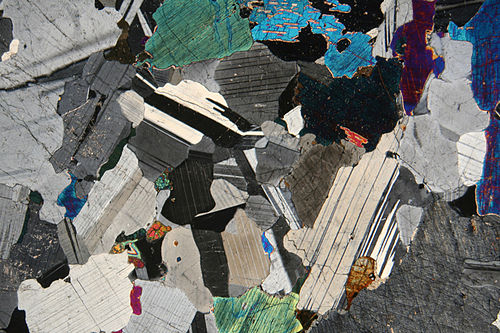Gabbronoun
(rock) Originally, a kind of serpentine; now generally a coarsely crystalline, igneous rock consisting of lamellar pyroxene and labradorite.
Gabbronoun
A name originally given by the Italians to a kind of serpentine, later to the rock called euphotide, and now generally used for a coarsely crystalline, igneous rock consisting of lamellar pyroxene (diallage) and labradorite, with sometimes chrysolite (olivine gabbro).
Gabbronoun
one of a family of granular intrusive rocks
Gabbro
Gabbro () is a phaneritic (coarse-grained), mafic intrusive igneous rock formed from the slow cooling of magnesium-rich and iron-rich magma into a holocrystalline mass deep beneath the Earth's surface. Slow-cooling, coarse-grained gabbro is chemically equivalent to rapid-cooling, fine-grained basalt.
Granitenoun
(rock) A group of igneous and plutonic rocks composed primarily of feldspar and quartz. Usually contains one or more dark minerals, which may be mica, pyroxene, or amphibole. Granite is quarried for building stone, road gravel, decorative stone, and tombstones. Common colors are gray, white, pink, and yellow-brown.
Granitenoun
Toughness; the quality of having a thick skin or being rough.
Granitenoun
A crystalline, granular rock, consisting of quartz, feldspar, and mica, and usually of a whitish, grayish, or flesh-red color. It differs from gneiss in not having the mica in planes, and therefore in being destitute of a schistose structure.
Granitenoun
plutonic igneous rock having visibly crystalline texture; generally composed of feldspar and mica and quartz
Granitenoun
something having the quality of granite (unyielding firmness);
Granite
Granite () is a coarse-grained igneous rock composed mostly of quartz, alkali feldspar, and plagioclase. It forms from magma with a high content of silica and alkali metal oxides that slowly cools and solidifies underground.




























